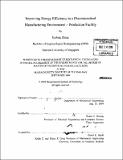Improving energy efficiency in a pharmaceutical manufacturing environment -- production facility
Author(s)
Zhang, Endong, M. Eng. Massachusetts Institute of Technology
DownloadFull printable version (8.800Mb)
Other Contributors
Massachusetts Institute of Technology. Dept. of Mechanical Engineering.
Advisor
Duane S. Boning.
Terms of use
Metadata
Show full item recordAbstract
The manufacturing plant of a pharmaceutical company in Singapore had low energy efficiency in both its office buildings and production facilities. Heating, Ventilation and Air-Conditioning (HVAC) system was identified to be the major energy consumer in the plant. An HVAC specific energy management tool was developed to monitor the energy efficiency and calculate the heat gains and cooling loads. In the office building, the HVAC operation schedule was revised, and motion detection lighting control was installed and configured to save electricity. In production facilities, house vacuum, process vacuum and dust collector were shut down during non-production time in Pharmaceutical Facility 2 (PF2). Statistical analysis using measured data was performed to verify the projected energy savings. Dehumidifier was disabled in Pharmaceutical Facility 1 (PF1) to relax the relative humidity from around 22% to 50%, while still maintaining it within the upper specification of 55%. Theoretical AHU-Dehumidifier models were built to find the optimum system settings with minimum energy consumption. With the implemented strategies, the annual energy consumption would be reduced by 6.68%, 6.58% and 2.32% in the office building, PF1 and PF2 respectively. The AHU-Dehumidifier models suggested a pre-cooling off-coil temperature of 15.50 C and a post-cooling off-coil temperature of 21 'C in face of the current humidity requirement to achieve minimum energy consumption.
Description
Thesis (M. Eng.)--Massachusetts Institute of Technology, Dept. of Mechanical Engineering, 2009. Cataloged from PDF version of thesis. Includes bibliographical references (p. 88-89).
Date issued
2009Department
Massachusetts Institute of Technology. Department of Mechanical EngineeringPublisher
Massachusetts Institute of Technology
Keywords
Mechanical Engineering.